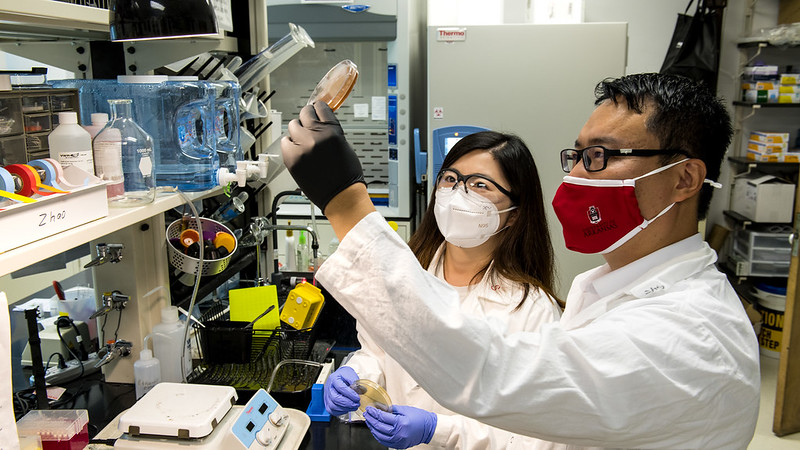Researcher Identifies Microbiota in the Bovine Respiratory Microbiome that can Counter Bovine Respiratory Disease

The Problem
BRD costs the beef industry as much as $2 billion per year, including animal death, reduction in feed efficiency and other effects of illness, as well as for prevention and treatment costs. U.S. feedlots are the most affected sector of the beef industry, experiencing up to $900 million in annual losses from BRD.
Feedlots present the greatest risk for the spread of BRD. More than 90 percent of large feedlots in the U.S. reported BRD as the most frequent disease, according to a report from the USDA’s National Animal Health Monitoring System in Fort Collins, Colorado. Zhao said the calves are subjected to significant stress as they go from weaning to shipping to the feedlot. There they are comingled with other animals from many locations. The first month at the feedlot is the highest period of vulnerability to the disease.
The Work
Microbiomes are colonies of bacteria — good, bad or indifferent — that occupy cavities in animal bodies. Jiangchao Zhao, associate professor of animal science, and his research team investigate these microbiota in agricultural animals to determine how the populations affect the animals’ health. In a USDA-NIFA-funded project, Zhao is identifying microbiota species that correlate with the occurrences of BRD in each of 90 calves, 30 each at three Division of Agriculture research locations — the Milo J. Shult Agricultural Research and Extension Center in Fayetteville, the Southwest Research and Extension Center at Hope and the Livestock and Forestry Research Station near Batesville. He and his collaborators are investigating the mechanisms of causation for BRD.
Using next-generation sequencing, Zhao is observing which genes are transcribed during a BRD infection, including the genes both in the pathogen and in the animals’ immune systems. This complicated, big data approach allows him to track the interaction between pathogen and host.
This research is combined with culturomics to isolate both good and bad microbiota from the bovine respiratory system.

The Results
Zhao’s lab team has identified several potential probiotics using this big data analysis. They are working to verify the beneficial effects of these microbiota to see if they can kill or inhibit the growth of pathogens in a laboratory. In follow-up research, Zhao will feed those “good” bacteria back to the calves to see if they are able to stop or reverse a BRD infection.
In related research, Zhao has developed an easier method for detecting BRD or the pathogens that can lead to the disease. The standard method for detecting BRD in sick or vulnerable cattle is to swab the nasopharyngeal cavity with a rhinostatics nasal swab. Zhao said the bovine nasopharyngeal cavity, the location of the respiratory microbiome, is very deep, reaching the entire length of the animal’s head to the top of the esophagus. Swabbing for a sample is a difficult procedure, and the cattle don’t much like it, either.
Zhao investigated the use of shorter swabs to sample the front of the calves’ nasal passage — the area immediately inside the nose. He was able to demonstrate that this easier method is as accurate as the standard method while causing far less discomfort to the animal.
The Value
The research could lead to the development of probiotic products that use the good bacteria as an intervention to cure or prevent BRD. Such products can be safer and more effective than antibiotics, to which bacteria can build resistance.
In a second phase of the nasal swab research, Zhao wants to develop a self-test kit that uses a system similar to the now-familiar home test kits for COVID-19. After sampling, the swab is smeared on a prepared test paper that will indicate whether the animal is BRD positive or negative.
Such a test may be used to determine if a calf has a higher concentration of either the “bad” bacteria that may lead to BRD infection or of the “good” bacteria that help prevent it.
Being able to identify which animals are at higher or lower risk of infection means veterinarians can focus intervention on fewer animals, saving money and lowering the risk of developing antibiotic-resistant bacteria.
About the Researcher

Jiangchao Zhao
Associate Professor of Animal Science
B.S., plant pathology, China Agricultural University, Beijing
M.S., plant pathology, China Agricultural University, Beijing
Ph.D., environmental microbiology, University of Wisconsin-Madison
Zhao’s research focuses on human and animal microbiomes utilizing the scientific techniques of multi-omics, big data and cultureomics. His work leads to understanding microbiome-diet-host interactions and development of probiotic, prebiotic and postbiotic products. His investigations have included the swine gut microbiome, the biogeography, inter-animal variation and dynamics of the bovine upper respiratory microbiome, and the correlation between human gut microbiota and longevity.

